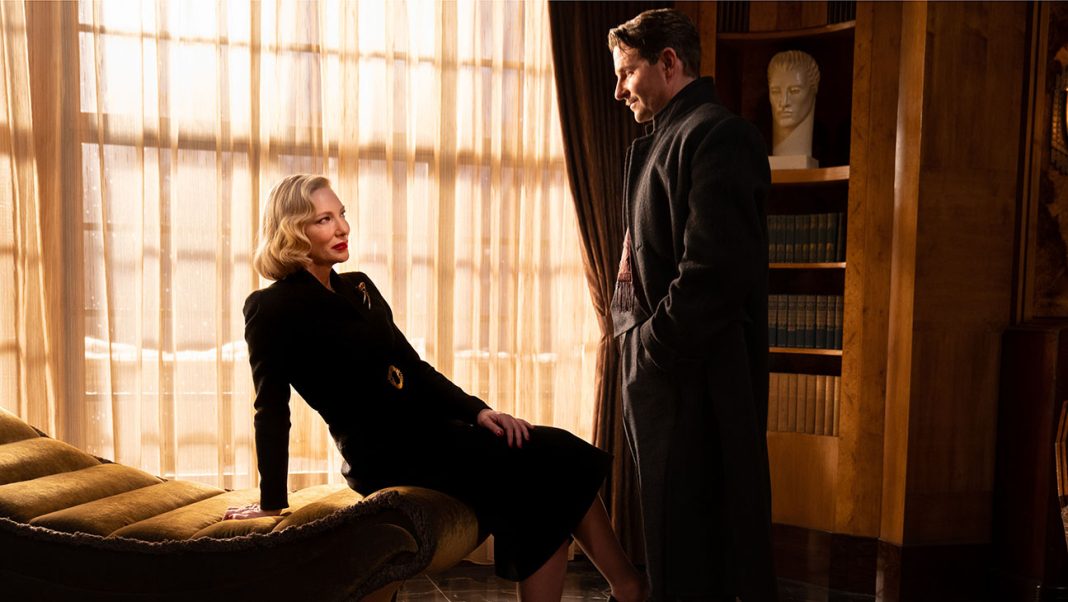If you’ve been following my reviews at the Beat, you may already know that I’m ambivalent about the English-language works of director Guillermo del Toro. All too often they just kind of bounce off of me, never quite hitting the same dark fable and otherworldly quality of his excellent trio of films from Mexico. I don’t know if it’s because the material he takes on from Hollywood is a little too filtered from the beauty of his own sensibilities that something doesn’t quite click, or if it’s for other reasons I haven’t picked up on. Even The Shape of Water, an experience I came out of feeling generally quite positive on, has aged like sour milk.
Del Toro’s newest effort is a second go at an adaptation of the William Lindsay Gresham novel, Nightmare Alley. I’ve read neither the book nor seen the Tyrone Power-starring film as of this moment, so I went in completely cold. With Nightmare Alley, I may finally have a Hollywood del Toro film that I’ve come out very positive on. Unlike The Shape of Water, my feelings for it continue to strengthen in the days since seeing it.
For those unfamiliar with the material like I was, Nightmare Alley centers on Stan Carlisle (Bradley Cooper), who is on the run due to mysterious circumstances. He wanders into a traveling carnival, where he immediately finds work as an extra hand, and eventually becomes ingratiated into their community. In particular, he befriends a husband/wife mentalist act (Toni Collette and David Strathairn) and takes a keen interest in an “electric girl” named Molly (Rooney Mara). Looking for a way to establish himself, Stan picks up mentalism and gets so good at it, he and Molly run off to the big city to establish a two-person show for socialites. That’s when the real trouble begins.
Over the last few days, I’ve wrestled with why this worked for me so well. I think the key point is how much it reminded me of those great EC Comics stories I read as a kid. It’s suitably dark, and it aligns well with the sort of O. Henry style conclusions that those excelled in. There’s even a fun little easter egg for old head Tales from the Crypt readers, where a homunculus named Enoch is a recurring prop that Stan keeps running into (the closest the film gets to anything approaching the supernatural). Outside of comics circles, this kind of approach is considered low art, but del Toro’s sensibilities work to its advantage here, bringing a prestige sheen and storytelling elevation that gives way to a haunting 2 hours.
Perhaps the biggest difference-maker is his partnership with co-screenwriter Kim Morgan, whose writing I’ve long admired when I first discovered it about 11 years ago. You long-time Criminal readers may remember her from the essays she provided in the back of those comics. Morgan has a keen interest in Old Hollywood and an incredible knowledge base of film and the historical contexts in which they were produced. She’s also a stellar writer to boot. Here, she and del Toro do something very smart by highlighting two key focal points from Gresham’s novel (based on what I can gather, again I haven’t read it). The first is the counterpoint between Stan’s mentalist act vs. the actual science of psychiatry through the introduction of the femme fatale of the piece, Dr. Lilith Ritter (Cate Blanchett, who has one of the greatest 1940’s faces I’ve ever seen). This creates a fascinating dichotomy between the psychological impact of con-artistry and how similar analytical skills, though of far greater knowledge and worth, are used to help those in need. But the other point of admiration in the screenplay they cook up is how well they establish Stan’s journey in a way that places the audience into his shoes, creating a greater understanding of how a man can so quickly fall from grace, and even underscoring that path in a way that gives way to empathy from passive viewers. It’s really something to see it take shape.
Nightmare Alley also provides a broad canvas for a number of fun performances, with the centerpiece of it being the interplay between Stan and Lilith, where the film really starts to crackle. Cooper is having a really good year performance-wise, after basically grabbing the year’s best film, Licorice Pizza, by the balls in a brief supporting turn. Now, for del Toro, he gives one of his strongest leads, which should put him in Oscar conversation, but probably won’t. Additionally Blanchett really vamps it up, and this is where that kind of energy is not only appropriate, but wholly welcome.
Nightmare Alley will likely join Crimson Peak as the director’s most divisive films, and I can’t help but think it’s the grim nature of the thing that’s going to drive a lot of that reaction. But if you just let it cast its Classic Noir spell on you, you’ll find it a richly rewarding slice of pulp topped off with some truly lush photography.
You can find more of Kyle’s work at ScreenRex







